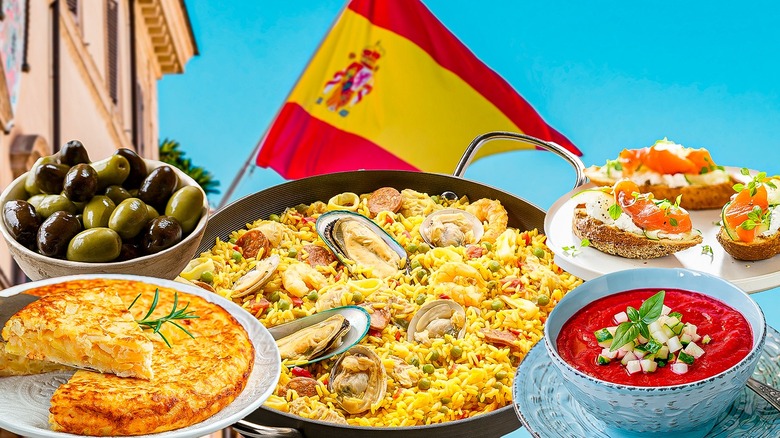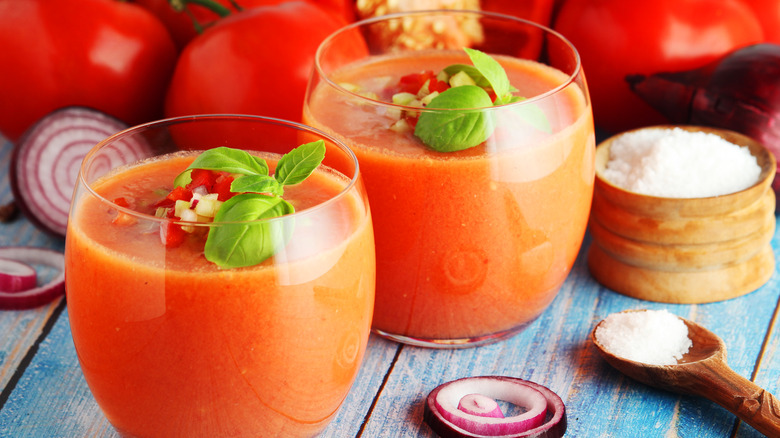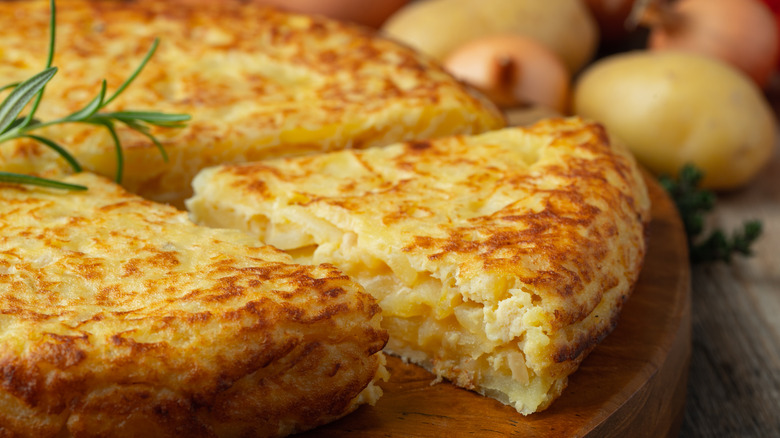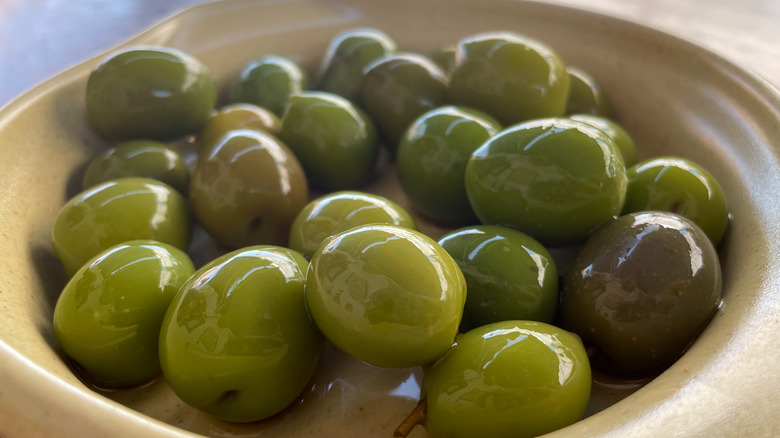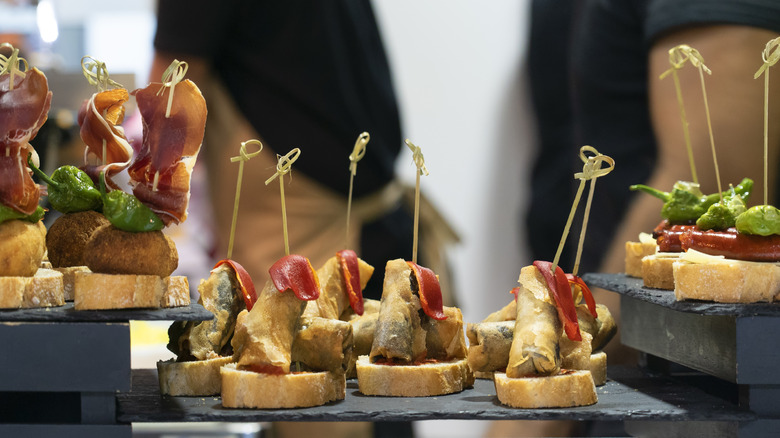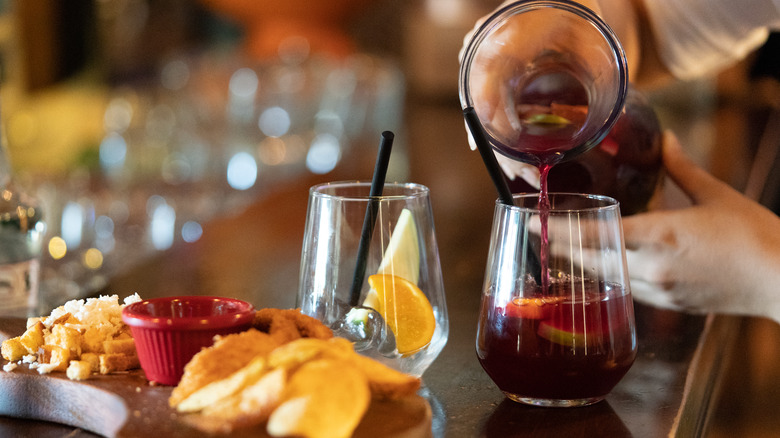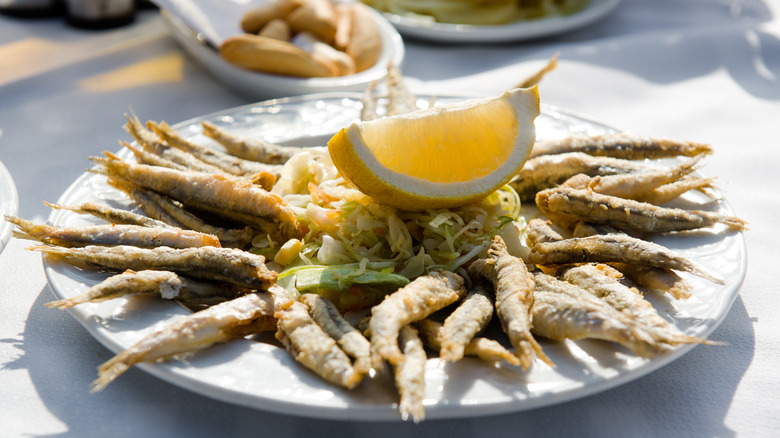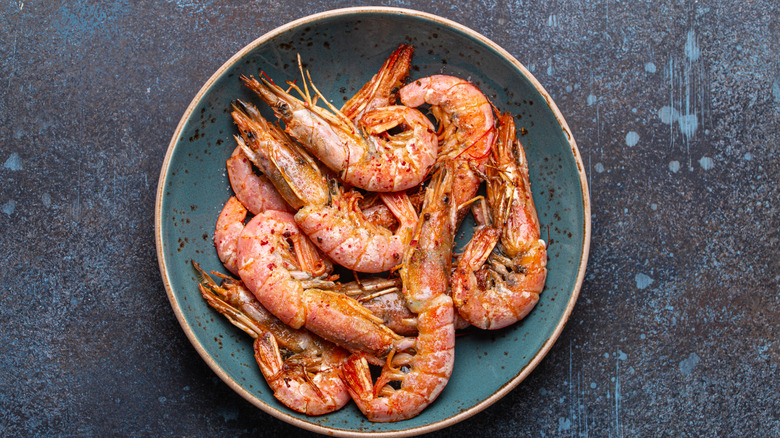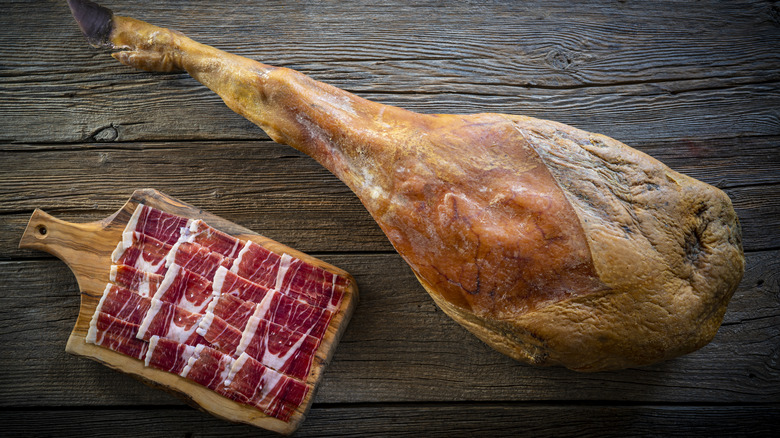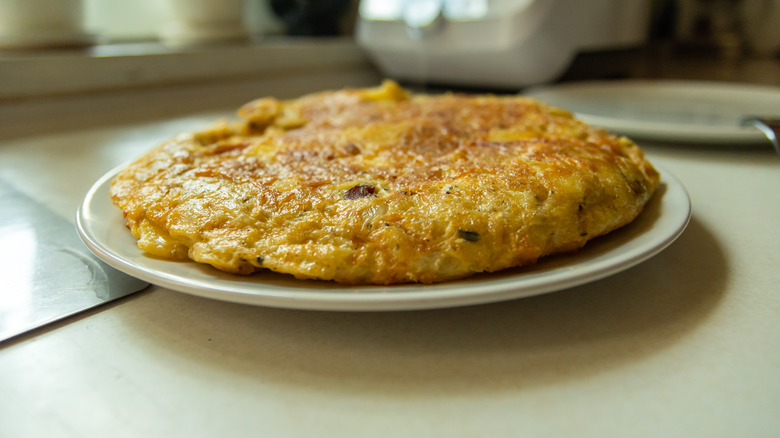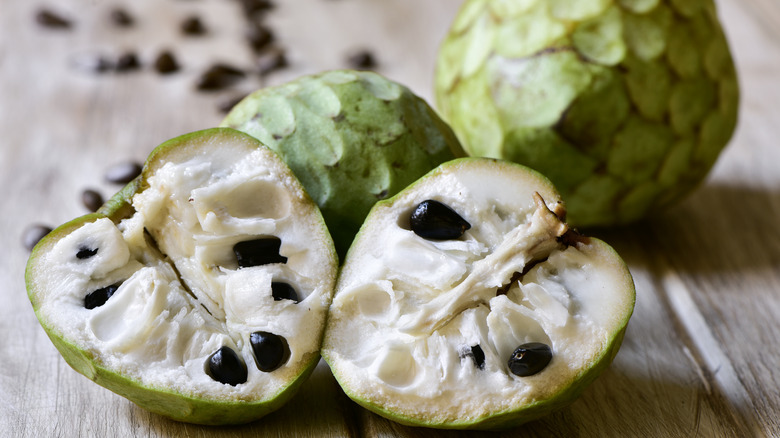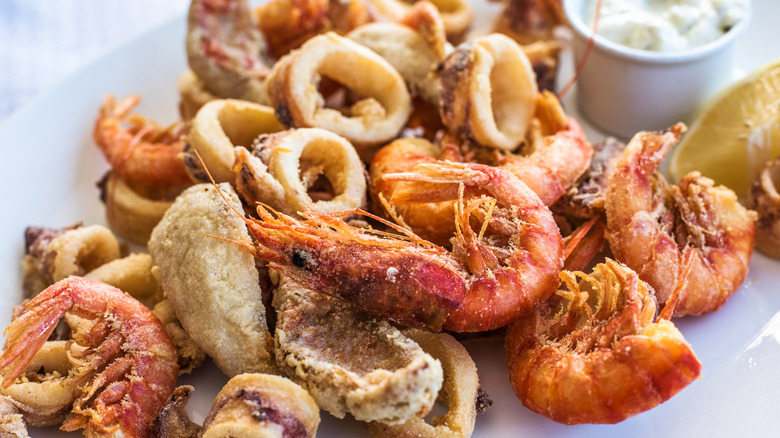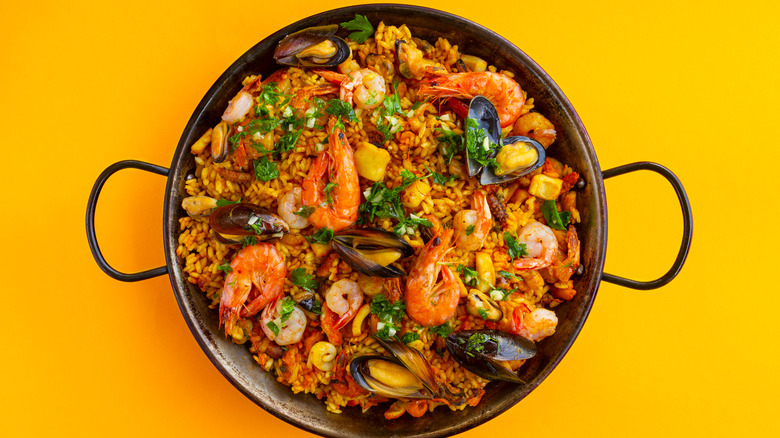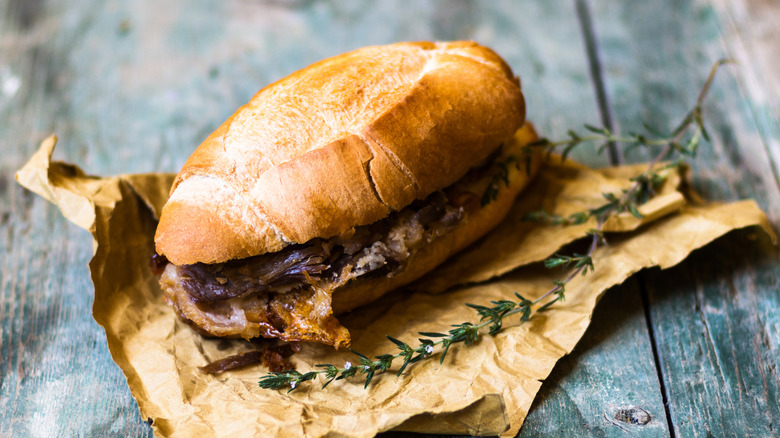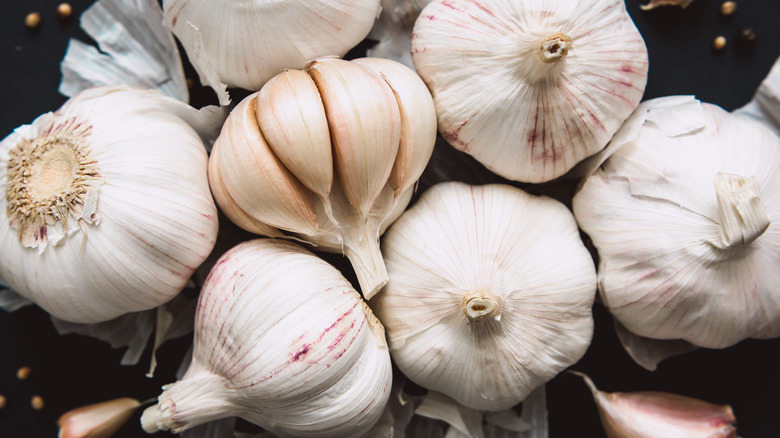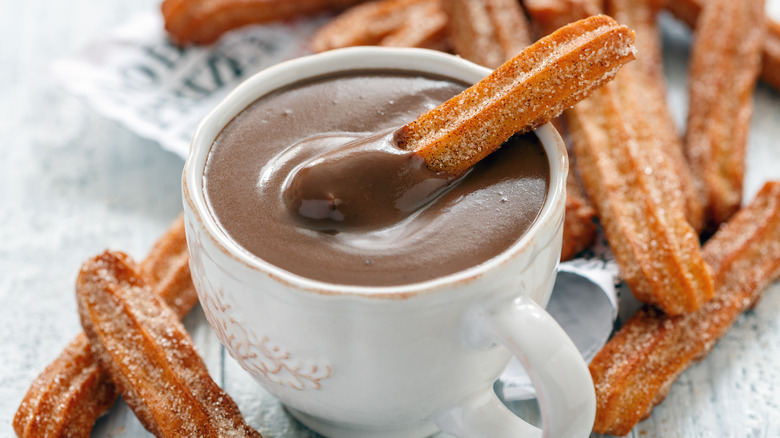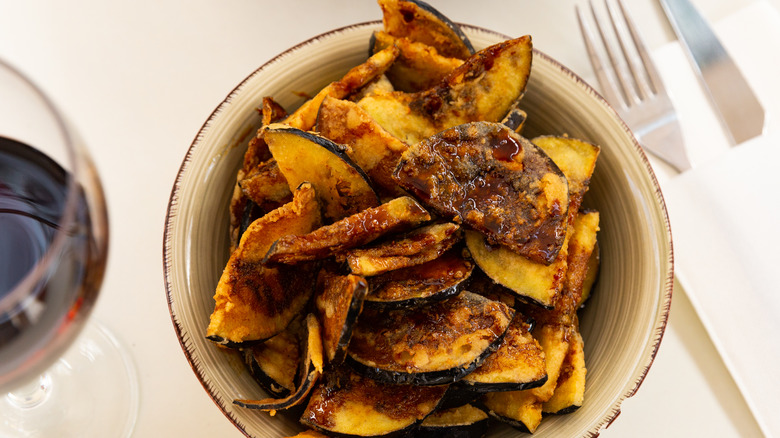17 Foods And Drinks You Need To Try In Andalusia, Spain
The region of Andalusia, which stretches across the south of Spain, is known for its hot beaches, cool mountains, rich history, and exceptional cuisine. Andalusia is home to the Sierra Nevada mountain range, the Guadalquivir river, and a unique variety of soil that has sustained a wealth of olive groves for thousands of years. This gorgeous landscape has provided the area with rich resources invaluable to many, and they all come to bear on Andalusian cuisine.
Andalusia's food is multifaceted, reflecting the region's diverse past and present. Exceptional produce, well-honed traditions and techniques, and the air itself takes this cuisine to tremendous heights. Some Andalusian dishes might be familiar to you — seafood paella, churros with chocolate, and gazpacho might even be among your favorite foods. Others, however, are likely to be new. There's no better way to expand your mind than travel, and Andalusian cuisine is at its best when it's created on its home turf. So why not take a trip to one of Spain's most glorious regions and taste what it has to offer? These are the foods and drinks you absolutely have to try when visiting Andalusia.
Gazpacho
If you've ever spent time in Andalusia, you're probably well aware of the blistering temperatures that characterize the region from spring to fall. Siestas — midday naps or rest periods — aren't just a cultural norm, they're a necessity. How else are you supposed to get through the hottest part of the day?
Also necessary for survival are cool, refreshing foods that can be eaten comfortably amidst soaring temperatures, when hunger often subsides. Produce like tomatoes, peppers, and cucumbers thrive in the hot sun, making gazpacho, a cold soup with Roman origins, a perfect choice. Gazpacho is made from all three of those gorgeous ingredients, plus stale bread, Spanish olive oil, and a splash of sherry vinegar. It's a perfectly refreshing choice, made from some of the area's finest ingredients.
Sardines de espeto
If you ever find yourself in Málaga, one of the best ways to enjoy a taste of local culture is to head towards the beach in search of sand-filled rowboats, set up for espetos (aka skewers). These distinctive landmarks signify chiringuitos, or seasonal beach bars, which are well worth a try; you won't find fresher seafood anywhere.
Sardines are perhaps the most classic fish to be found in a chiringuito: They're threaded onto sword-like skewers whose ends are stuck into the sand and cooked over a wood fire (often made from olive branches) until they're just charred. They're then liberally sprinkled with sea salt and served immediately with lemon. You can also find whole fish, shrimp, octopus, and squid cooked and served in this fashion. This technique became popular in the late 19th century, and it's only gotten better with age.
Tortilla española
Though they've become a key ingredient in many Spanish dishes, potatoes were not introduced into the Spanish diet until the late 16th century. The potato-rich tortilla española didn't become commonplace until a few centuries later, as a solution to the hunger created by an ongoing famine. After this point, the tortilla española — and potatoes as a whole — became a frequent and much loved star of the Spanish table.
A hearty and filling dish, the tortilla española is a delicious mix of soft potato, creamy eggs, and sweet bits of sautéed onion. It's the perfect tapa to enjoy alongside a glass of sherry, cava, or crisp white wine, and can be eaten at any time of day.
Olives
Once upon a time, the region of Andalusia kept Rome supplied with a steady stream of olive oil. Today, you can still find a plethora of olive groves across the area, especially in the southern region. This lovely landscape is known for its Mediterranean climate, which helps olives thrive.
Nowadays, 30% of global olive oil production and 20% of table olive production takes place in Andalusia. This makes olives one of the region's most celebrated and protected resources, as they provide economic stability and ecological strength. They're also absolutely delicious with nothing more than a little oil and salt. Olives are good for the Earth, good for the economy, and great for the taste buds. They're such a staple of Andalusian culture and cuisine, it's nearly impossible to visit the region and not partake in this superfruit.
Tapas
While tapas, meaning snacks or small plates, are a culinary staple of the Spanish food scene, not all tapas are the same. It's essential to understand the custom of each region before you head out to enjoy them.
Despite the norms of sit-down tapas restaurants in the U.S., most tapas in Spain are enjoyed standing, as an accompaniment to alcoholic drinks like beer, sangria, sherry, or wine. In most areas of Andalusia, tapas come at a cost and with a choice, the city of Granada being an exception. Order a drink at a bar and delight in the surprise snack that will come alongside it, often based on local ingredients. While you will not be able to customize what is brought out to you, you can expect that it will be served free of charge, encouraging and prolonging an evening out by keeping costs down and hangovers to a minimum.
Sangria
Nothing quite says southern Spain like a glass of cold sangria in the hot sun, often accompanied by a plate of tapas. Like many other mainstays of Spanish cuisine, the drink — a mixture of water, wine, and various fruits, herbs, and spices — is a product of Roman influence. It's also evidence of an ancient way of eliminating unsafe bacteria in drinking water — alcohol and sugar kill it off. Nowadays, the drink can be made with soda water, depending on the desired level of sweetness. Fruits that provide a certain amount of acidity, such as lemons, limes, green apples, berries, and oranges, are also a welcome addition to any glass or pitcher.
The term sangria has roots in the word sangre, meaning blood, — a reference to the beverage's deep crimson color. Though it can come in other colors and varieties, red sangria is most traditional and commonplace throughout the country.
Pescados fritos
As the region borders the Mediterranean Sea, it's no surprise that seafood is prevalent within the food of Andalusia. So it goes with the presence of olive oil within this cuisine; some of the finest in the world comes from this orchard-abundant region. Put the two together, and the presence of pescados fritos, or fried fish, on Andalusian menus is inevitable ... and delicious.
Deep frying is found throughout Spanish cuisine, from fish to croquettes. It's especially common in areas like Seville, Huelva, and Cadiz, where the presence of smaller fish like anchovies, baby squid, and cuttlefish is plentiful. Deep-frying fish is said to have come from the Sephardic Jewish communities that once lived in Spain and Portugal, prior to the Inquisition. These little fried fishies make a perfect drinking snack — cold, carbonated Spanish lager cuts through the deep-fried fat to create a satisfying balance of flavor and texture.
Gambas a la plancha
Gambas, or shrimp, are much-loved in Andalusia, and gambas a la plancha are especially popular. As with much of the seafood from this region, gambas a la plancha dazzles by using relatively simple techniques and highlighting the top-tier quality of its ingredients.
Gambas a la plancha are a typical tapa, traditionally accompanied by a cold glass of whatever you fancy. They also make a fantastic snack and are commonly sold and eaten in chiringuitos. While shrimp in the U.S. are typically peeled and deveined, Spanish shrimp are served whole, with the head and shell intact. For gambas a la plancha, they are flash-fried and finished with lemon and salt, before being immediately served. Fine-tuning the art of peeling them is part of the eating experience.
Jamón iberico and jamón de Trevélez
The Spanish are well known for their dedication to cured meats. This proclivity encompasses everything from cecina, a lesser-known dried and cured beef, to pork products like jamón serrano. The most well-known jamón serrano is jamón iberico, which is made from a small brown pig breed known for feasting on acorns. This gives their meat a distinctive and highly sought-after flavor. Said pigs are grown and raised in the regions of the country closest to Portugal and the western parts of Andalusia, making it an easy and delicious choice if visiting the area. It is most often served thinly sliced, and makes for an excellent tapa.
There are many other varieties of cured pork worth seeking out, including jamon de Trevélez, which comes from — you guessed it – the tiny village of Trevélez. This mountain village of fewer than 1,000 people is known for its high elevation and naturally cured meats. The combination of elevation (the highest in the country!) and dry mountain air has provided an ideal climate for curing since the 1700s, when the product first became popular.
Tortilla del Sacromonte
Granada is a special part of Andalusia with a long and unique history. Among many other things, it's the birthplace of tortilla del Sacromonte. Though it is made with eggs, the tortilla del Sacramonte is not your typical omelet: Its staple ingredient is lamb or calf brains and, sometimes, testicles. These brains are paired with many other ingredients, including different types of meats, potatoes, and peas, creating a hearty egg dish.
Like tortilla española, tortilla del Sacramonte is typically cooked until it's slightly crusty on the outside while remaining soft and creamy inside. Even the cooking process is pretty much the same, and the final product is served upside-down. If you're an adventurous eater, it's worth checking out for the unique ingredients alone.
Chirimoya
After sampling this fruit many (many) times, we've concluded that the chirimoya might be one of the most satisfying and decadent delicacies on the planet. Known as the custard apple in English, the chirimoya is an unassuming avocado-meets-artichoke-looking fruit with a thin, slightly dimpled green skin that conceals sweet, creamy, custard-like flesh.
The fruit thrives in hot climates, including the Andalusian coast. Chirimoyas can be found in such abundance in shops, grocery stores, and fruit stands that we highly recommend traveling around the area with a spoon. This way, you can easily pick a chirimoya up and enjoy it wherever you are. Pierce the thin green skin with the tip of your spoon and break the fruit in half, then scoop out the flesh and enjoy. The shiny black seeds are too hard to manage, so we recommend working around them or spitting them out like watermelon seeds after each mouthful.
Fritura Malagueña
From the American South to the Chinese coast, fried fish is universally beloved. Malagueños (residents of Malaga) prove to be no exception to this rule: This region has been into fried ocean goodness since the 1700s, andfritura Malagueña is the proof. This dish simply consists of the city's local produce — specifically, its small fish and seafood — fried to crispy perfection.
The day's catch varies, and so does fritura Malagueña. It might contain squid, red mullet, mackerel, prawns, whiting, or any other small seafood. The catch is dusted with flour and deep-fried until crunchy and golden. Served with a wedge of lemon and a sprinkling of sea salt, this is the perfect beach or bar snack, especially when accompanied by a cold beer.
Paella
Paella is a dish that highlights some of Spain's best resources: seafood, saffron, and rice. Andalusia is one of the country's biggest rice producers, its access to fresh seafood from the Mediterranean is unparalleled, and some of the world's best saffron is produced in central Spain. It's no wonder, then, that this region of the country dishes out some of the best paella around.
Given the cost of seafood and saffron, the expense of making seafood paella at home can be enormous. But in Andalusia, it's economical. So when you're there, take advantage of your unique opportunity: Eat the best possible paella made with some of the country's finest ingredients. It'll come at a much more reasonable price, due to accessibility, and it will be spectacularly fresh.
Pringá
Like other items on this list, pringá is considered an anytime dish in Andalusia. It's made from low and slow-stewed chicken, pork, and sausages, which become incredibly tender, and are often fried until crispy. This deliciousness is typically slid into a soft roll or spread onto a slice of bread, then eaten with gusto. Pringá is the perfect meal to line the stomach before a night of drinking, a delightful mid-drink snack, and a tried-and-true morning-after remedy sure to soothe an aching head.
You don't need alcohol to enjoy this tasty dish, however — it's delicious in any context. Notably, pringá is probably most popular in Seville, though you can and should seek it out in various sandwich and tapas places across Andalusia.
Ajo blanco
In a region like Andalusia, where temperatures are known to soar into the 90s and beyond for months at a time, having an arsenal of simple and cold dishes isn't a luxury, but a requirement for survival. While gazpacho is the reigning cold soup of the region, it's not the only one. Ajo blanco is an incredibly refreshing alternative.
Ajo, which means "garlic" in Spanish, clues you into this dish's most prominent flavor. As it's also a bright, creamy white, it's a pretty dramatic contrast to bright red, tomato-laden gazpacho. Like gazpacho, though, this soup's texture comes from its use of stale bread, alongside a blend of almond, garlic, and vinegar. What results is a mild and creamy dish that can be paired with a variety of toppings.
Churros con chocolate
Nothing says "Spanish vacation" quite like staying out all night dancing, then topping off the experience with a morning visit to the local churrería for churros con chocolate. It's an experience we highly recommend having at least once in your life: Watching the sunrise as you sink freshly fried dough into a cup of thick, spoon-coating chocolate is pretty much perfect.
Unlike a mug full of hot chocolate, this chocolate is thick, with an almost hot fudge-like consistency, which perfectly contrasts the crispy deep-fried churro. It's an excellent hangover remedy, but it doesn't have to be — churros con chocolate is a much-loved breakfast indulgence among pretty much everyone. Notably, unlike Mexican churros, Spanish churros often lack a cinnamon-sugar topping, especially when they're made to be paired with chocolate. But we promise, you won't miss it.
Berenjenas con miel
Prominent within North African and Middle Eastern cuisine, eggplants have done their fair share of globe-trotting. This includes a trek through Spain, which Andalusian cuisine reflects. The region's long-standing Middle Eastern, North African, and Sephardic Jewish influences come to bear in its eggplant dishes, and berenjenas con miel are a great example.
Deep-fried eggplants are delicious on their own, but this dish ups the ante by drizzling them with honey. Perennially popular, berenjenas con miel show up on menus all across the region and are also a traditional Hanukkah food among Sephardic communities. You can also find this dish at local tapas restaurants in cities like Granada and Cordoba.
